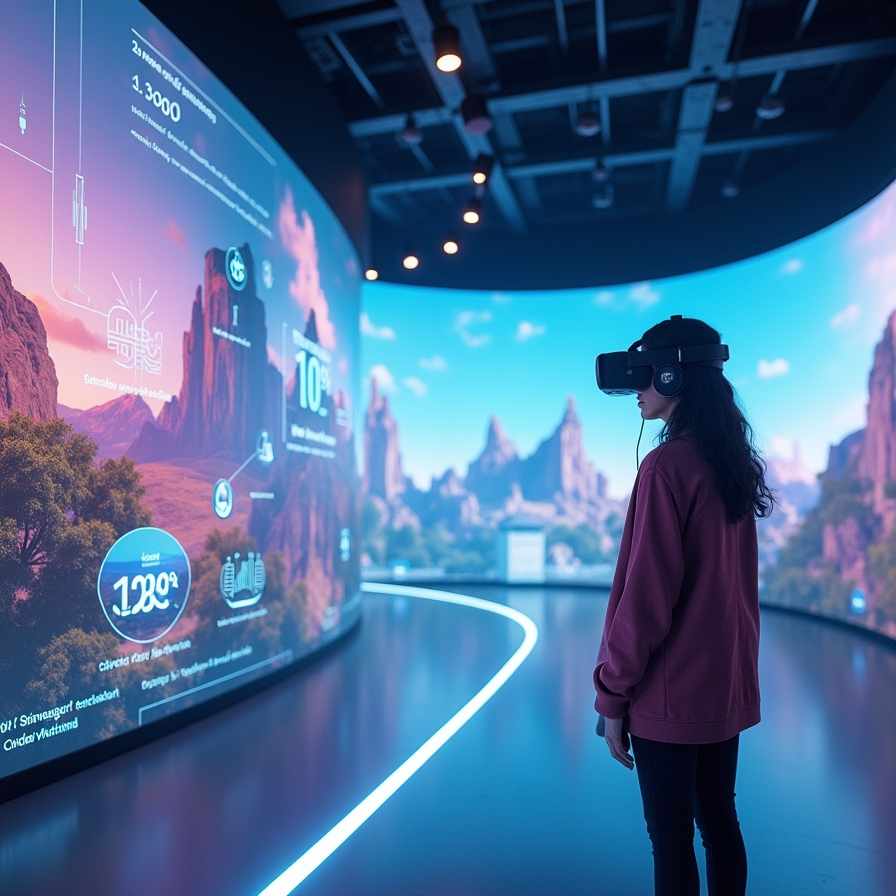
That’s right — a whopping of global travelers say they are more likely to book a destination after experiencing it through a virtual tour.
This number might shock you, but it reveals how digital transformation is reshaping industries we once thought were “touch and feel” only.The rise of virtual tours isn’t just a cool tech feature; it’s completely altering how we explore, shop, and experience spaces — from real estate to museums to travel.
Let’s dive into why virtual tours have become a must-have in today’s digital-first world.
What Is a Virtual Tour?
A virtual tour is an immersive digital experience that lets you explore a location online as if you were physically present.Think of Google Street View — but dial it up.
Today’s virtual tours use 360-degree photography, panoramic videos, and interactive hotspots to let users “walk through” spaces like hotels, galleries, homes, or landmarks.
It’s like teleporting with your smartphone or VR headset — except without the jet lag or expense!
Why Virtual Tours Matter: Not Just for Fun
Sure, virtual tours are cool and entertaining.
But behind the fun, they drive real business impact.
Here’s how:
Real Estate: According to Zillow, homes with virtual tours get more qualified leads. Buyers can explore every room before even stepping inside.
Travel and Tourism: Hotels using virtual tours see booking rates increase by up to ,as reported by Hospitality Net.
Retail: E-commerce brands offering virtual showroom experiences have seen conversion rates jump .
In short, virtual tours aren’t just a “nice-to-have” anymore — they’re essential tools for businesses to attract, engage, and convert customers.
How Virtual Tours Work: A Simple Breakdown
So, what’s under the hood of a virtual tour?
At its core, a virtual tour combines high-resolution images or videos stitched together using software to create an interactive environment.
Here’s the easy-to-digest version:
Capture: A photographer or drone takes 360-degree images or panoramic videos of the space.
Software stitches the visuals together, aligning angles and correcting colors.
Enhance: Interactive hotspots, audio narration, or embedded videos are added to make the experience richer.
Deploy: The final product is hosted on a website or VR platform, ready for users to explore Imagine it like building a choose-your-own-adventure digital map where the viewer controls the journey.
Key Benefits of Virtual Tours for Businesses
1. Boost Engagement and Time-on-Site
A standard webpage or listing might hold a visitor’s attention for 1-2 minutes.But add a virtual tour? Suddenly, users stay 5-10 minutes or longer exploring.That’s more time to impress, inform, and convert.
2. Build Trust Through Transparency
People trust what they can see.A virtual tour eliminates surprises by showing spaces exactly as they are, boosting confidence among buyers, renters, or visitors.It’s like test-driving a car before signing the deal — the more real it feels, the more comfortable people get.
3. Expand Global Reach
Not everyone can hop on a plane or schedule an in-person visitVirtual tours break down geographic barriers, letting someone from New York explore a villa in Bali or a coworking space in Berlin — anytime, anywhere.
Key Industries Winning With Virtual Tours
Real Estate
Agents and brokers are using virtual tours to show properties 24/7, no appointments needed.This not only saves time but attracts more qualified buyers who’ve already “walked through” the space online.
Hospitality and Travel
Hotels, resorts, and even cruise lines now offer virtual tours to showcase rooms, amenities, and destinations.
One report by Travel Weekly found that of travelers consider virtual previews before making a booking.
Education
Universities and schools are rolling out virtual campus tours to attract international students. It’s like giving a prospective student a VIP backstage pass without them ever leaving their home.
Museums and Attractions
Cultural institutions like The Louvre or The Smithsonian now offer virtual tours, opening up world-class art to anyone with an internet connection.
Virtual Tours vs. Static Images: What’s the Big Deal?
You might wonder: Why not just post more photos or videos?
Here’s the key difference.
Static content is linear — you watch or look, and that’s it.
Virtual tours are interactive — you control where to go, what to look at, and how deeply to explore.
It’s the difference between watching a cooking video and actually stepping into the chef’s kitchen.
That sense of control creates engagement, emotional connection, and memorability — three things every marketer dreams of.
Future Trends: Where Are Virtual Tours Headed?
The future of virtual tours is looking even more immersive.We’re seeing the rise of AR (Augmented Reality) and VR (Virtual Reality) integrations, where you can walk through a space using a headset and feel like you’re really there.
Artificial Intelligence is also joining the party, enabling personalized tours that adjust based on your interests, behavior, or preferences.
Imagine visiting a museum online, and the system guides you automatically to exhibits you’re most likely to love.
Getting Started: How Can Businesses Use Virtual Tours?
If you’re a business owner wondering how to tap into this trend, here’s a simple roadmap:
Assess Your Needs What space or experience would benefit most from a virtual tour? (Properties, showrooms, campuses, venues?)Hire a Pro Look for experienced 360-degree photographers or agencies that specialize in virtual tours.
Enhance With Content Add hotspots, product info, or booking links to turn passive browsing into active engagement.Promote It Share your virtual tour across your website, social media, email campaigns, and listings to drive traffic.
Final Thoughts: Why Virtual Tours Are No Longer Optional
The digital world is more visual, interactive, and experience-driven than ever.Virtual tours hit all three marks, giving businesses an edge in attracting today’s savvy, research-driven consumers.
With travelers booking after virtual exploration and real estate leads jumping by nearly with virtual tours, the numbers speak for themselves.
In a world where people want instant access, transparency, and immersive experiences — virtual tours deliver.
Write a comment ...